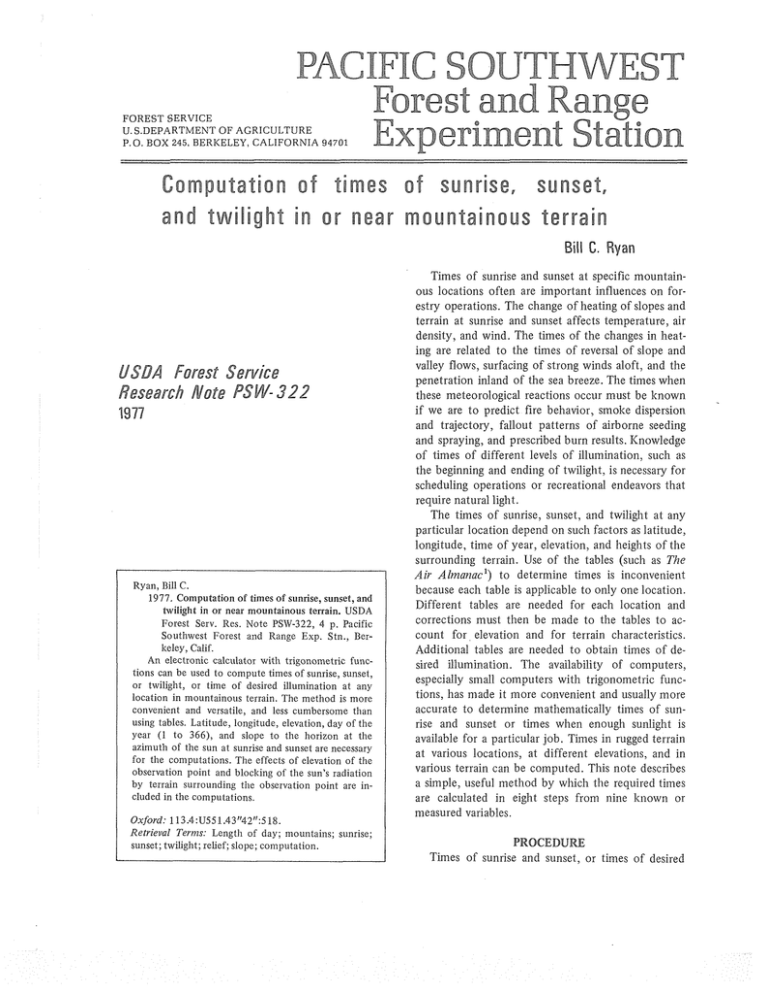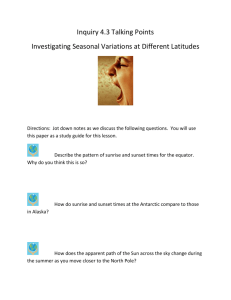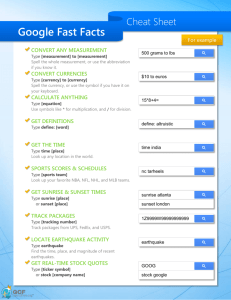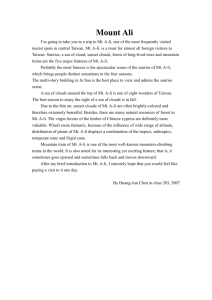R and SOUTHWEST Forest
advertisement

FOREST SERVICE
U. S.DEPARTMENT O F AGRICULTURE
P . 0 . BOX 245, BERKELEY, CALIFORNIA 94701
@ SOUTHWEST
Forest and R
Experime
Computation of times of sunrise, sunset,
a n d twilight in o r near mountainous terrain
Bill 6. Ryan
USDA Forest Service
Research NO& PSW- 322
1977
1
I
Ryan, Bill C.
1977. Computation of times of sunrise, sunset, and
hvilight in or near mountainous tersain. USDA
Forest Serv. Res. Note PSW-322, 4 p. Pacific
Southwest Forest and Range Exp. Stn., Bcrkeley, Calif.
An electronic calculator with trigonometric functions can be used t o compute times of sunrise, sunset,
or twilight, or time of desired illumination at any
location in mountainous terrain. The method is more
convenient and versatile, and less cumbersome than
using tables. Latitude, longitude, elevation, day of the
year (1 t o 366), and slope to the horizon at the
azimuth of the sun at sunrise and sunset are necessary
for the computations. The effects of elevation of the
observation point and blocking of the sun's radiation
by terrain surrounding tlie observation point are included in the computations.
Oxford: 113.4:U551.43"42":518.
Retrieval Terms: Length of day; mountains; sunrise;
sunset; twilight; relief; slope; computation.
I
Times of sunrise and sunset at specific mountainous locations often are important influences on forestry operations. The change of heating of slopes and
terrain at sunrise and sunset affects temperature, air
density, and wind. The times of the changes in heating are related to the times of reversal of slope and
valley flows, surfacing of strong winds aloft, and the
penetration inland of the sea breeze. The times when
these meteorological reactions occur must be known
if we are to predict fire behavior, smolce dispersion
and trajectory, fallout patterns of airborne seeding
and spraying, and prescribed burn results. ICnowledge
of times of different levels of illumination, such as
the beginning and ending of twilight, is necessary for
scheduling operations or recreational endeavors that
require natural light.
The times of sunrise, sunset, and twilight at any
particular location depend on such factors as latitude,
longitude, time of year, elevation, and heights of the
surrounding terrain. Use of the tables (such as The
Air Almanac1) to determine times is inconvenient
because each table is applicable to only one location.
Different tables are needed for each location and
corrections must then be made to the tables to account for elevation and for terrain characteristics.
Additional tables are needed to obtain times of desired illumination. The availability of computers,
especially small computers with trigonometric functions, has made it more convenient and usually more
accurate to determine mathematically times of sunrise and sunset or times when enough sunlight is
available for a particular job. Times in rugged terrain
at various locations, at different elevations, and in
various terrain can be computed. This note describes
a simple, useful method by which the required times
are calculated in eight steps from nine lcnown or
measured variables.
PROCEDUm
Times of sunrise and sunset, or times of desired
illumination, at a specific location in mountainous
terrain, can be determined by obtaining the information listed in steps 1 through 9 in the checksheet
fig. I) and performing the calculations in steps 10
through 17. The equations can be solved with a
hand-held electronic calculator with trigonometric
functions, or more easily, with a programmable calculator with at least six registers, four of which may
be stack registers. The checksheet may be reproduced
and the copies used to record the intermediate values
obtained on a nonprograrnmable calculator.
An example of calculations of times of sunrise and
sunset at Riverside, California, is included infimre I.
The observed time of sunrise for this day and location
was 0647 PST and tlle observed time of sunset, 1648
PST. The Box Springs Mountains to the east of Riverside create a slope to the horizon of 7.5", which on
this date delayed sunrise by approximately 40 minutes. The Santa Ana Mountains to the west caused
sunset to be 10 minutes earlier than it would have
been in a nonmountainous area. If the site had been
at sea level instead of at 306 m , sunrise would have
been about 3 minutes later and sunset 3 minutes
earlier.
ACCURACY
Calculations are most accurate in midlatitudes
from 30" to 40" North. When elevation and height of
surrounding terrain are not considered, as in the
tables of The Air Almanac, calculations are generally
within 1 minute .of the table value but vary to 3
minutes near the vernal equinox. These errors occur
because of the simplified relationships used in the
calculations. Other inaccuracies occur due to variations of refraction because of varying atmospheric
temperature lapse rates. Some error may occur in
mountainous areas if the azimuth of the sun at sunrise and sunset is approximated (see equations (6) and
(7) below) and not obtained by observation. In comparisons of computed times with observed times of
sunrise and sunset in mountainous areas between 30"
North and 40" North, differences of 4 to 5 minutes
were common. Illumination due to scattering and
indirect radiation may vary because the amount of
indirect radiation received at a point depends on the
size and distance of the land mass or clouds that
obstruct the direct radiation. The errors due to these
variables are difficult to quantify. They tend to be
large in high latitudes where atmospheric temperature
lapse rates can vary greatly and where the sun rises
and sets obliquely over tlle mountains.
'
BACh(GR0Ul"dD~DDEVELOPMENT
The equations shown in the checksheet Cfig. 1)are
given in order of use in a typical calculation. The
more detailed discussion here follows the order of
development of the procedure. Additional background and explanation are given in the discussion
that follows.
The time of sunrise (when the upper limb of the
sun appears on the horizon), the beginning of morning twilight, or the beginning of required illumination
can be estimated by the relationship
t, = (h,
+ 180)/15 - At - Q
(1)
and the time of sunset (when the upper limb of the
sun can last be seen on the horizon), the end of
evening twilight, or the end of required illumination
by
t,, = (h, t 180)/15 - At - Q
(2)
where h, is the hour angle of the sun (the angle from
the meridian of the observer, negative to the east in
degrees) in the morning, 11, is the hour angle in the
evening, At is the factor that corrects time to Local
Standard Time, and Q is the equation of time.
The hour angle of the sun in the morning is estimated as
h,
=
-arc cos {[-sin (0.8
+ R - S,)
- sin g5 sin dl /(cos @ cos d))
(3
and the hour angle in the evening as
h, = arc cos {[-sin (0.8 t R - S,)
- sin (6 sin d] /(cos (6 cos d))
(4)
where R is the angle between the sun's rays tangent
to the earth at sea level and tangent at the elevation
of the site; S, is the slope to the horizon at the
azimuth of the sun at sunrise, and S, is the slope at
sunset; @ is the latitude of the observer; and d is tlle
declination of the sun.
Corrections for refraction of the radiation by the
atmosphere and the semidiameter of the sun are included in the factor 0.8. Refraction varies with variation of the vertical density lapse rate along the path
of the solar radiation through the atmosphere, so
some variation of times of sunset and sunrise will
occur.
The factor
lo6) /
lo6 + 1.32 E)]
R = arc cos [(6.37
6.37
(5)
where E is the elevation (meters)of the site, corrects
the hour angle at sunrise and sunset to account for
variations of the depression angle that are due to
elevation of the observation point. The constant 1.32
is applied to fit variation of the depression angle that
LOCATION
DATE
(from 1 t o 3 6 6 ) .
1. Day of t h e y e a r
1
D =
2. E l e v a t i o n of t h e s i t e ( m e t e r s ) .
E =
3. L a t i t u d e of s i t e ( d e g r e e s and d e c i m a l d e g r e e s ) .
@
4. L o n g i t u d e of s i t e ( d e g r e e s and d e c i m a l d e g r e e s ) .
L =
=
Ar
=
90
+ 31
A =
+ 7.9)
c o s (0.986 D
7. Azimuth of s u n a t s u n s e t ( d e g r e e s from n o r t h )
-
A = 270
3 1 c o s (0.986 D
+
A
=
I
I
1
1
(306)
( 3 2 0 m)
(33.95"N)
S
=
(+ti kh)
(110")
(250")
7.9)
8 . S l o p e t o h o r i z o n a t a z i m u t h of s u n a t s u n r i s e ( d e g r e e s ) .
1976)
(177.25"W)
5. D i f f e r e n c e L o c a l S t a n d a r d Time and Greenwich Mean Time ( h o u r s ) . H =
6. Azimuth of s u n a t s u n r i s e ( d e g r e e s from n o r t h )
I
,
1
(Now. 1 ,
(7.5")
9. S l o p e t o h o r i z o n a t azimuth of s u n a t s u n s e t ( d e g r e e s ) .
2.0" )
1 0 . C o r r e c t i o n f o r e l e v a t i o n of s i t e ( d e g r e e s )
a . For s u n r i s e and s u n s e t
. 106)/(6.37 -
R = a r c cos [(6.37
b. For c i v i l t w i l i g h t , R
lo6 +
1.32 E)]
5.2
=
c. For n a u t i c a l t w i l i g h t , R
11.2
=
11. D e c l i n a t i o n of t h e s u n ( d e g r e e s )
d
23.45 s i n [0.973 (D - 8 1 . 5 ) ]
=
12. Hour a n g l e 1 of sun a t s u n r i s e ( d e g r e e s from m e r i d i a n )
h
= - a r c c o s { [ - s i n (0.8
(cos @ c o s d ) }
-
+R
- S )
-
sin @ sin dl/
= a r c cos
=
(-72.17")
13. Hour a n g l e 1 of s u n a t s u n s e t ( d e g r e e s from
h
h
90
{ [ - s i n (0.8
+R
meridian)
- S ) - sin @ sin dl/
h
=
(79.23")
( c o s @ c o s d ) 1 + 90
1 4 . C o r r e c t i o n t o o b t a i n L o c a l S t a n d a r d Time (decimal h o u r s )
At =
A t = H - L/15
Q
1 5 . E q u a t i o n of t i m e , Q ( i n d e c i m a l h o u r s )
Q = [0.7 s i n (-0.986
D)
+ sin
(-1.97
D
-
15.78)]/6
=
( 0 . 1 8 kh)
('0.26 kh)
16. ~ i m of
e ~s u n r i s e ( h o u r s and d e c i m a l h o u r s )
t.
=
sr .
(hr
+ 180)/15 -
A t
-
Q
1 7 . ~ i m of
e ~ s u n s e t ( h o u r s and d e c i m a l h o u r s )
t
SS
=
(hs
+
180)/15
.
-
At
-
tss = ( 1 6 5 0 P.d.2.,
Q
l 1 f S = S , t h e n h = -h
Times of twil i g h t S o r txmes of d & i r e d r s o l a r i l l u m i n a t i o n
a r e d e t e r m i n e d by u s i n g t h e same p r o c e d u r e s
and e q u a t i o n s l i s t e d i n s t e p s 1 2 t h r o u g h 1 7 .
The v a l u e of R, from s t e p 1 0 , d i f f e r e n t i a t e s
t h e r e s u l t i n g time.
76.84 kh)
or
d a y l i g h t s a v i n g t i m e , add 1 h o u r . To
o b t a i n minutes, multiply decimal p o r t i o n
of answers 1 6 and 17 by 60.
Figure I-This checksheet shows the steps used for computation of times of sunrise and sunset in uneven
terrain. A sample computation ( i n parentheses) is included. Time of twilight can also be computed by the
method shown.
is due to variation of refraction caused by the different path lengths of the sun's rays through the atmosphere.
For calculation of the time of the beginning of
morning civil twilight and the time of ending of
evening civil twilight, R = 5.2; for nautical twilight, R
= 11.2. Tlze time of the beginning of morning civil
twilight and the time of ending of evening civil twilight are defined as the times (in good conditions and
in the absence of other illumination) when the degree
of illumination is such that the brightest stars are just
visible and terrestrial objects can be easily distinguished. This occurs when the sun is 6" below the
horizon. Morning nautical twilight begins and evening
nautical twilight ends when the sun is 12" below the
horizon. The degree of illumination of the beginning
of morning nautical twilight and end of evening nautical twilight (in good conditions and in the absence of
other illumination) is such that the general outlines of
ground objects are visible-although the horizon is
probably indistinct-all detailed operations have become impossible, and all navigation stars can be seen.
These are arbitrary levels of illumination and other
depressions can be determined to correspond to different levels necessary for a particular purpose or job.
To calculate times of greater or less illumination
smaller depression angles can be used, or for times of
less illumination greater depression angles can be
employed. Depression angles for required levels of
illumination are more variable in mountainous areas
than on level terrain because the sunlight is often
scattered by land masses. Some adjustment of the
term R may be necessary to simulate the depression
angle for the necessary illumination. The same R
value can be used for different times of the year and
for a large area.
The adjustment often necessary in mountainous
terrain, when the solar radiation is blocked by land
masses, is made using the slope to the horizon along
the azimuth, which is either directly observed or
approximated. The azimuth of the sun at sunrise can
be approximated by
A, = 9 0 + 3 1 cos (0.986 D + 7.9)
where D is the day of the year. The azimuth at sunset
can be approximated by
A, = 270 - 31 cos (0.986 D + 7.9)
(7)
Equations (6) and (7) provide good approximations
of the correct azimuth angles from 30" to 45" North
but are not accurate in other latitudes.
The slope to the horizon along the azimuth where
the sun's rays are last blocked in the morning is S,;
where the sun's rays are last blocked in the evening it
is S,. These slopes can be obtained from a topographic map or by surveying the site.
The sun's declination d can be estimated from
d = 23.45 sin [0.973 (D - 8 I S ) ]
(8)
The declination of the sun is its angular distance
north (+) or south (-) of the celestial equator.
The two factors, At and Q, are needed in equations (I) and (2) to equate solar time and clock time.
The time at the observer's longitude is changed to
Local Standard Time by the factor
A t = H - L/15
(9)
where H is the time difference between Greenwich
Mean Time and Local Standard Time, and L is the
longitude of the site. (For example, the time difference H between Greenwich Mean Time and Local
Standard Time in the Pacific Standard Time Zone is
-1-8 hours.)
The equation of time Q compensates for the difference between clock time and solar time caused by
the variation in the time of complete rotation of the
earth relative to the sun. It: may be approximated by
the relationship
Q = [0.7 sin (-0.986 D)
+sin(-1.97D- 15.78)]/6
(10)
This equation is accurate to about 1 2 minutes.
'
NOTE
United States Naval Observatory. 1975. The air
almanac. Washington, D.C., 734 p.
(6)
The Author
BILL C. RYAN, research meteorologist, is studying problems in fire
meteorology, with headquarters at the Station's Forest Fire Laboratory,
Riverside, California. He earned a degree in chemistry at the University of
Nevada (B.S. 1950), a degree in meteorology at Texas A&M University
(M.S. 1964), and a degree in geography-climatology at the University of
California at Riverside (Ph.D. 1974). He has been at the Station's Forest
Fire Laboratory for the past 10 years.
*u.
4
S . GPO:
1978-793-
723


